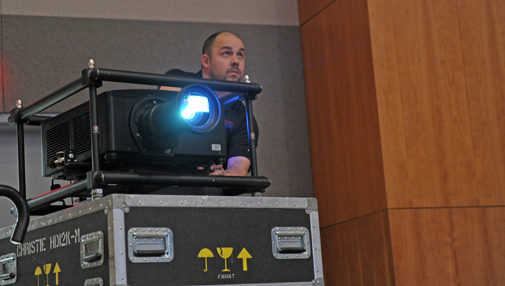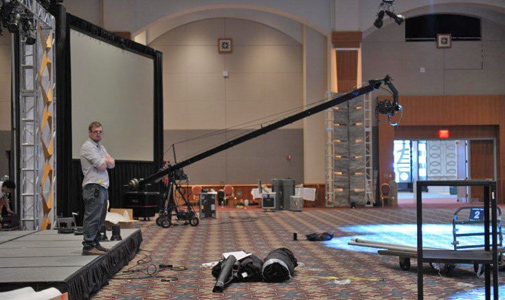Conference & Stage Expo
Learning Opportunities for Projection Technology

Setting up USITT's major events involves more technology each year. Coordinating them allows an exploration of new techniques, especially projection.
Photos/Richard Finkelstein
Projections of one form or another have been a part of performance for as long as theatre has existed, but relatively recent advancements in technology have led to an explosion of activity in the field of projection design. Along with these advancements have come opportunities for learning. USITT's Annual Conference has seen an expanding role in projection for its major events, paralleling what is happening within the industry. Sessions on the topic keep expanding.
The vocabulary alone of projection design can be intimidating for the uninitiated. While many are now adept at projecting still images by means of Power Point and a classroom LCD projector, the field encompasses so much more. So, what's the next step in developing a projection toolbox?
Programs of study are becoming more common in the United States and across the pond. Live Design's Master Class series has offered an annual projection class since 2005, providing access to innovators like Wendell Harrington and Zack Bovary. USITT's programming continues to increase each year, and 2014 promises to bring more opportunities to connect with projection manufacturers, vendors, and designers than ever before. Sven Ortel's website (www.projctn.com) offers tutorials alongside philosophical approaches into his own professional work as well as a burgeoning community archive to trace past and ongoing development. Regional theatre conferences are now featuring excellent seminars like those offered at SETC in 2013 by Patrick Pagano of the University of Florida and University of Tennessee Professor Joe Payne.
While there are stunning examples of visionary projection work from legendary artists such as Erwin Piscator and Josef Svoboda, projection in the theatre prior to the last 30 years was relatively limited by time, money, and the quality of the technology itself. In the 1980s, new materials and progress in transistor manufacturing allowed the development of the first liquid crystal display (LCD) and digital light processing (DLP) projectors which offered significant improvements in brightness and expense. The emergence of affordable computers and digital media sources allowed designers to set aside their 35mm slide projectors or large format projectors in favor of this new, more flexible medium.
Since then, projection design (or video design to some) has come to envelop more complicated technology in pursuit of storytelling. Most projection designers now generate original content, drawing upon experience in film or animation. Content can be played back from dedicated media servers, packaged as all-inclusive hardware and software solutions, or from a laptop running server software like Isadora, WATCHOUT, or QLab, all designed with flexibility and performance as a priority.
Multiple video cards and an appropriately powered computer processor allow live capture to be added to the mix. Images can be mapped onto specific shapes or spread seamlessly across multiple shapes with software packages like MadMapper or TorsionBlend. Users have quickly integrated input tools like the iPad and the Xbox Kinect sensor as triggers for truly interactive projection work.
Like all productions, those creating special events at USITT"s Annual Conference have had to expand their roles and responsibilities. In 2013 the team included Jason Winfield, Jason Winfield (Media director), Kristen Geisler (lighting director), Mo Stroemmel (NPS Video artist), and Andrew Trow (technical director) as well as myself. For 2014, Chuck Hatcher will be handling sound, and Ms. Geisler (Lighting Director), and Mr. Stroemmel (TD and NPS Video Artist) will be returning to assist.
The 2014 Annual Conference will use projection in new ways, as technologies shift and expand. See www.usitt.org/2014 for sessions and exhibitors targeting this advancing field.

Scott Olinger oversees the main event room coming together for the 2013 Annual Conference in Milwaukee, including projection and lighting.

